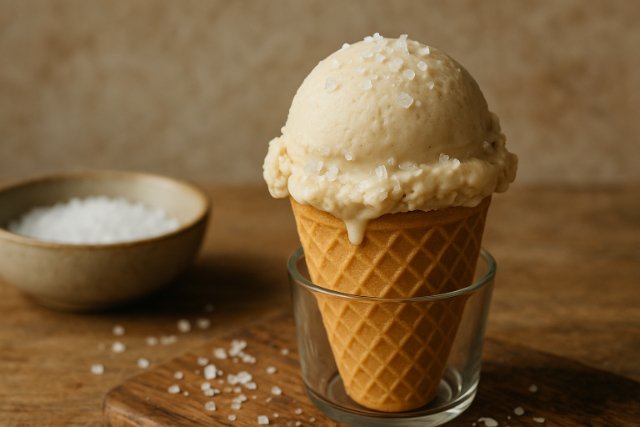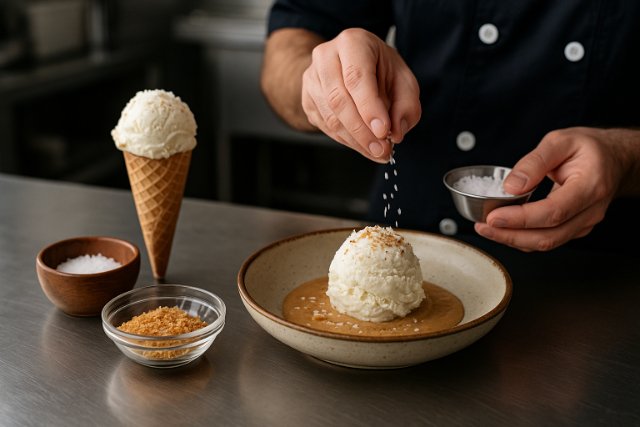Ice cream has long been a symbol of indulgence and nostalgia, but today’s dessert landscape is evolving beyond sweetness. Enter salty ice cream a culinary innovation that blends salt, umami, and savory elements with traditional ice cream bases to create an entirely new flavor experience. This fusion of sweet and savory satisfies modern palates craving contrast, depth, and surprise.
In recent years, chefs and artisan makers have pushed frozen desserts into uncharted territory. By incorporating ingredients like sea salt, cheese, bacon, miso, or olive oil, they’ve transformed the classic treat into something layered, intriguing, and sensory. Salt not only enhances sweetness but also introduces a complexity that invites diners to taste more consciously.
The growing interest in flavor experimentation and molecular gastronomy has turned salty ice cream from a niche curiosity into a global dessert trend. Whether it’s a scoop of Filipino queso, a drizzle of olive oil gelato, or a caramel swirl topped with smoked salt flakes, these frozen creations are redefining what dessert can be both scientifically and culturally.
What is Savory or Salty Ice Cream and How Does It Differ From Regular Ice Cream?
Salty ice cream is a frozen dessert that intentionally integrates salt, savory, or umami ingredients such as sea salt, cheese, bacon, or olive oil to contrast the sweetness of the base. Unlike traditional sweet-only ice creams, salty versions explore the balance between sweetness, fat, and salinity, creating deeper and more complex flavor experiences.
A typical ice cream base combines cream, milk, sugar, and sometimes eggs. In salty or savory ice creams, the formulation tweaks that balance: sugar levels are reduced slightly, while mineral-rich salts or savory emulsions (like miso or cheese) are added. The goal is not to make the ice cream “salty,” but to enhance the perception of sweetness and texture through controlled contrast.
From a sensory perspective, salt modulates flavor perception by suppressing bitterness and emphasizing desirable notes. It also interacts with the fat and sugar phases to make ice cream feel smoother and more indulgent. As chefs experiment with umami compounds such as aged cheeses or fermented pastes salty ice cream has evolved from novelty to gourmet art form.
How Does Salt or Savory Elements Affect Ice Cream Chemistry and Flavor Perception?
Salt affects the freezing point, mouthfeel, and sweetness perception of ice cream. When dissolved in the liquid base, salt lowers the freezing point slightly, creating a softer, more scoopable texture. In small doses (around 0.5–1% of total weight), it also enhances sweetness and rounds off bitter or astringent notes.
In flavor chemistry terms, sodium ions interact with taste receptor cells, amplifying signals for sweetness and umami. This makes the brain perceive the dessert as richer, even when sugar content is lower. It’s a core principle of flavor layering, where contrast creates synergy why caramel tastes better with sea salt or why chocolate benefits from a pinch of salt.
From a molecular gastronomy perspective, salt stabilizes emulsions and prevents ice crystal overgrowth during freezing, contributing to a creamy mouthfeel. This is why fine sea salts, smoked salts, or miso extracts are preferred over plain table salt they offer mineral nuances and subtle complexity.
What Kinds of Salts or Savory Ingredients Are Used in Salty Ice Cream?
Salty ice creams employ both traditional salts and umami-rich ingredients to create diverse profiles. Below is a breakdown of common variants:
| Ingredient Type | Examples | Flavor Role |
| Sea Salts | Fleur de sel, Maldon, Himalayan pink | Adds clean salinity, crunch, and mineral notes |
| Smoked or Flavored Salts | Smoked alder, truffle salt | Introduces aromatic depth and savory richness |
| Cheese & Dairy | Parmesan, cheddar, cream cheese | Provides umami, fattiness, and creamy tang |
| Fermented Elements | Miso, soy sauce, kombu | Adds earthy, aged notes and umami balance |
| Fat-based Savories | Olive oil, bacon, brown butter | Contributes aroma and silky mouthfeel |
Cheese ice cream (known as “queso” ice cream in the Philippines) and olive oil gelato from Italy are early examples of salty–sweet hybrids that inspired global reinterpretations.
Why Has Salty Ice Cream Emerged as a Flavor Trend Now?

Salty ice cream’s rise mirrors the broader sweet-and-savory revolution in desserts. As consumers seek novelty, the once-clear line between meal and dessert blurs. Salty elements in desserts satisfy the modern palate’s preference for contrast and complexity rather than pure sweetness.
Market research shows that flavor fatigue among dessert lovers has pushed chefs toward culinary experimentation. Social media trends like “weird flavor challenges” and artisan tasting flights encourage curiosity. Simultaneously, global cuisines with savory-sweet traditions (e.g., Asian or Mediterranean) have normalized the idea of salt in sweets.
In gastronomy, chefs see salty ice cream as a canvas for umami exploration, aligning with molecular gastronomy and fusion dining trends. Its novelty also provides a marketing differentiator for ice cream shops seeking Instagram-worthy uniqueness.
What Food Science Explains the Appeal of Sweet + Salty Combinations?
Sweet and salty flavors stimulate opposing but complementary taste receptors. Sugar activates T1R2 and T1R3 receptors for sweetness, while sodium activates ENaC channels for saltiness. When both are triggered, the brain’s reward system interprets the contrast as more pleasurable and multidimensional.
This biological response known as “hedonic synergy” explains why foods like salted caramel or chocolate-covered pretzels are so satisfying. The same principle powers salty ice cream: the salt sharpens sweetness and softens bitterness, leading to a cleaner, more dynamic flavor curve.
Additionally, salt enhances aroma perception by boosting volatile compound release, meaning that buttery, nutty, or smoky flavors become more pronounced. This synergy is why chefs call salt “the amplifier of sweetness.”
What Consumer and Culinary Drivers Are Behind the Trend?
Salty ice cream’s growth is driven by both consumer curiosity and chef creativity. Younger demographics seek sensory novelty, favoring hybrid foods that tell a story like bacon ice cream or miso caramel. For chefs, savory ice cream represents the intersection of art, science, and showmanship.
Culinary schools and food tech startups have accelerated the trend by teaching flavor pairing algorithms and molecular balance principles. The influence of social media, gourmet pop-ups, and flavor-forward brands (like Salt & Straw, Jeni’s, and OddFellows) has further normalized salt-infused desserts.
From a business perspective, salty ice cream offers higher perceived value and differentiation. Limited-edition flavors with savory inclusions often command premium pricing and free publicity.
What Are Popular Salty Ice Cream Flavor Variations Around the World?

The diversity of salty ice creams mirrors cultural interpretations of sweet-savory balance. From Asian cheese ice creams to Mediterranean olive oil gelato, the variations showcase how chefs reinterpret salt through local ingredients.
| Region | Popular Variant | Key Ingredient | Cultural Note |
| Philippines | Queso Ice Cream | Cheddar cheese | A nostalgic staple served in bread buns |
| Japan | Miso Caramel Ice Cream | White miso | Combines caramel sweetness with savory umami |
| Italy | Olive Oil Gelato | EVOO, sea salt | Luxurious texture and fruity finish |
| United States | Bacon Ice Cream | Candied bacon | Iconic sweet-savory crossover dessert |
| France | Salted Butter Caramel | Beurre salé | Origin of the modern salted caramel trend |
How is Filipino Queso (Cheese) Ice Cream Made and Consumed?
Queso ice cream, a beloved Filipino creation, blends mild cheddar cheese into a classic custard base. Cubes of cheese are folded into the churned mixture, offering bursts of saltiness within creamy sweetness. It’s traditionally served inside a pandesal (bread roll) or alongside ube (purple yam) for color and flavor contrast.
The cheese contributes both salt and fat, enhancing creaminess and mouthfeel. Queso ice cream’s enduring popularity highlights how salty ice cream can feel familiar, not experimental rooted in comfort and nostalgia.
What About Emerging or Chef-driven Flavors (E.g., Potato, Miso, Etc.)?
Innovative chefs are reimagining salty ice cream through nontraditional ingredients. Potato-based ice cream introduces starchy creaminess, while miso, soy, or truffle add depth and umami. Bacon, olive oil, and brown butter have become signatures of experimental parlors.
At Michelin-level restaurants, ice cream now appears as part of savory tasting menus, paired with seafood or vegetables. The goal isn’t dessert sweetness it’s temperature contrast and textural harmony within the meal. These applications redefine what “ice cream” means beyond dessert.
How Do You Make Salty Ice Cream at Home Step by Step?
Making salty ice cream at home requires precision to balance salt, sugar, and fat. The foundation remains a custard or cream base, but the seasoning must be measured to avoid over-salting.
- Prepare the Base: Combine 2 cups heavy cream, 1 cup whole milk, ¾ cup sugar, and 4 egg yolks. Heat gently until thickened.
- Add Salt or Savory Element: Mix in ½ to 1 teaspoon fine sea salt or a small amount of cheese, bacon fat, or miso paste.
- Chill and Churn: Cool the mixture completely, then churn until creamy.
- Fold in Mix-ins: Add crushed pretzels, caramel swirls, or cheese bits during the last few minutes.
- Freeze: Store 4–6 hours for firm texture.
What is an Easy Sweet-and-salty Ice Cream Recipe?
Here’s a basic Sea Salt Caramel Ice Cream recipe for beginners:
Ingredients:
- 2 cups heavy cream
- 1 cup milk
- ¾ cup sugar
- ½ cup caramel sauce
- 1 teaspoon sea salt
- 1 teaspoon vanilla extract
Instructions:
- Warm milk, sugar, and caramel until dissolved.
- Add cream, salt, and vanilla; chill thoroughly.
- Churn in an ice cream maker.
- Drizzle extra caramel and sprinkle flaky salt before freezing.
This formula creates the quintessential sweet-salty balance: creamy richness offset by sharp mineral salinity.
How to Make a Sea Salt Ice Cream Custard Base?
For a more advanced variant, use an egg-based custard. Heat milk and cream with sugar, temper egg yolks, and add 0.75% sea salt by weight. This small amount enhances body and prevents excessive freezing. Finish with caramel, chocolate, or olive oil swirl for complexity.
Avoid table salt if possible its sharpness and fine granules can make flavors harsh. Instead, use fleur de sel or Maldon flakes for a delicate finish.
How Should You Serve and Pair Salty Ice Cream?
Salty ice cream pairs beautifully with contrasting textures and complementary flavors. Serve it with warm desserts like brownies, tarts, or fruit crumbles to create temperature contrast. A drizzle of olive oil or honey enhances gloss and aroma.
Chefs often present salty ice cream alongside savory dishes, such as seared scallops, roasted figs, or prosciutto crisps. The salt bridges sweet and savory components, making it versatile beyond dessert menus.
What Toppings or Mix-ins Complement Salty Ice Cream?
Ideal pairings emphasize texture, aroma, and contrast. Consider:
- Candied nuts or pralines for crunch
- Caramel or chocolate shards for sweetness
- Pretzel crumbs or bacon bits for savory depth
- Infused oils (basil, truffle) for aromatic enhancement
- Herbs like thyme or rosemary for complexity
These toppings not only elevate flavor but also support visual appeal crucial for social media presentation.
What Desserts or Savory Pairings Work Well (Cakes, Sauces, Wine)?
Pair salty ice cream with dark chocolate cake, apple pie, or citrus tart for balanced sweetness. On the savory side, it complements foie gras, aged cheese platters, or balsamic reductions. For wine, go with sweet Riesling or sherry, which accentuate salt’s minerality.
In fine dining, chefs use salty ice creams as palate cleansers between courses, emphasizing contrast and refreshment.
For Ice Cream Businesses and Chefs How to Innovate With Salty Ice Cream

Innovation in salty ice cream lies in layering flavor experiences and storytelling. Start with a base flavor that’s familiar (e.g., vanilla, caramel) and add subtle savory twists like olive oil or smoked salt. Consumers accept adventurous flavors more readily when anchored by something recognizable.
Small-batch makers can test new variants through limited releases or tasting flights. Collect feedback and analyze which combinations resonate emotionally nostalgic, indulgent, or daring. Use social media polls or “build your flavor” campaigns to engage customers.
From a production standpoint, consistency is key: salt must be evenly distributed to avoid hot spots. Stabilizers and emulsifiers like guar gum or lecithin help maintain balance in larger batches.
What Flavor Combinations Are High Potential but Underexplored?
Emerging pairings include:
- Corn & sea salt (echoing elote)
- Parmesan & honey
- Olive oil & lemon zest
- Soy caramel & sesame
- Brown butter & sage
These hybrids capture both comfort and intrigue ideal for modern dessert menus.
How to Market Salty Ice Cream and Test Consumer Acceptance?
Effective marketing leans on education and experience. Highlight the sensory story “why salt makes sweetness sing.” Offer tasting notes and pairing guides. Use chef endorsements or behind-the-scenes videos to demystify the process.
Consumer testing can involve blind pair comparisons between sweet-only and sweet-salty versions. Track preference, recall, and emotional descriptors. Studies show that consumers often rate salty variants as more “premium” or “complex.”
What Are Criticisms, Risks or Myths Around Salty Ice Cream?
Some critics label salty ice cream as a culinary gimmick. However, flavor trend data shows steady growth in savory dessert demand. The main risk lies in balance too much salt overwhelms sweetness, while too little feels indecisive.
Another concern is perception: traditional consumers may associate “salty” with spoiled dairy or off-flavors. Clear labeling and taste education solve this.
Environmentally, artisanal salts and dairy sources impact sustainability; ethical sourcing and reduced-waste practices strengthen brand credibility.
Does Salt Make Ice Cream Melt Faster?
Salt itself doesn’t directly cause faster melting once frozen. While it lowers freezing point during preparation, the final ice cream’s melt rate depends more on fat, sugar, and stabilizer ratios. Properly churned salty ice cream melts similarly to traditional versions.
Is It Just a Novelty or a Lasting Subcategory?
Evidence points to permanence. Salted and savory ice creams now occupy a niche similar to dark chocolate or espresso flavors once unconventional, now mainstream. With expanding ingredient access and consumer sophistication, salty ice cream is evolving into a recognized subgenre of premium frozen desserts.
Where Can Consumers Try Salty Ice Creams (Brands, Shops, Limited Editions)?
Consumers can try salty ice creams at a variety of boutique creameries, experimental dessert shops, and through limited-edition collaborations with well-known brands. Salt & Straw, a popular artisanal ice cream brand based in Portland, frequently releases salty flavor combinations such as “Sea Salt with Caramel Ribbons” and “Salted, Malted, Chocolate Chip Cookie Dough.”
In major cities like New York, Los Angeles, and Tokyo, high-end dessert bars and fusion eateries often include salty ice cream flavors on rotating menus. Dominique Ansel Kitchen in New York has been known to feature savory ice creams infused with ingredients like olive oil and sea salt.
Limited-edition salty ice creams are occasionally released through collaborations between food brands and ice cream makers. For instance, Lay’s once partnered with a creamery to produce a salty potato chip-flavored ice cream, and Hidden Valley Ranch collaborated with Van Leeuwen to create a ranch-flavored ice cream that leaned heavily into salty and savory profiles.
Which Brands or Shops Have Released Salted Ice Cream or Salted Caramel Variants?
- Salt & Straw (USA): Rotating menu includes olive oil, blue cheese & pear, and bacon flavors.
- Jeni’s Splendid Ice Creams: Features salty caramel, everything bagel, and sweet potato brûlée.
- Häagen-Dazs: Global releases of salted caramel, brown butter, and truffle-infused variants.
- Tokyo Gelato Bars: Experiment with soy sauce or seaweed bases.
These brands highlight how salt bridges traditional and avant-garde dessert profiles.
What Limited Editions or Pop Culture Flavors Exist?
Pop culture collaborations have introduced quirky releases like:
- Potato Chip Ice Cream (Lay’s collab)
- Bacon & Bourbon Ice Cream
- Blue Cheese & Fig from experimental chefs
- Sea Salt Pikachu Ice Cream in Japan
Limited editions create buzz, reinforcing salty ice cream’s position as a trend that delights and surprises.
Conclusion
Salty ice cream represents more than a quirky culinary twist it’s a sensory evolution of frozen desserts. By harmonizing sweet, salty, and umami elements, it captures the modern appetite for complexity, story, and contrast. Whether crafted at home, served in a tasting menu, or sold by artisan brands, salty ice cream embodies how flavor science meets creativity.
As the sweet-savory movement matures, expect salty ice cream to become not just a novelty, but a cornerstone of contemporary dessert culture a small pinch of salt redefining how we experience sweetness.
Explore more insightful and valuable content on our blog VeoTag.com! Stay updated with helpful tips, expert advice, and in-depth articles that enhance your knowledge.
Read Also:
1. twitter media viewer: Download Tweets & Media
2. Why Updates Are Important JotechGeeks: Key Benefits & Best Practices
3. crypto30x.com ocean: Deep Dive into Features 2025
4. Gramhir Pro: Ultimate Guide to AI Image Generation
5. twitter profile viewer: view any public X profile anonymously
6. Twitter Account Viewer: How to Browse X Profiles Without Logging In
7. 5starsstocks.com: Review & Deep Analysis
FAQ’s
No. Salted caramel is one example, while salty ice cream spans a spectrum of flavors like cheese, bacon, olive oil, and miso.
Start with 0.5–1.5% of the base weight using fine or flaky sea salt. Adjust to taste too much can overpower sweetness.
Yes, but sea salt or kosher salt provides better mineral balance and more pleasant flavor dispersion.
Not significantly. Melt rate depends more on fat, sugar, and stabilizers than salt alone.
Bacon, parmesan, miso, and even potato-based ice creams have appeared in experimental menus.
Because salt enhances sweetness, reduces bitterness, and deepens flavor complexity through sensory contrast.
It’s evolving into a premium subcategory within artisan and gourmet ice creams.
Try candied nuts, caramel ribbons, pretzels, chocolate shards, or even cheese crisps and herbs.

